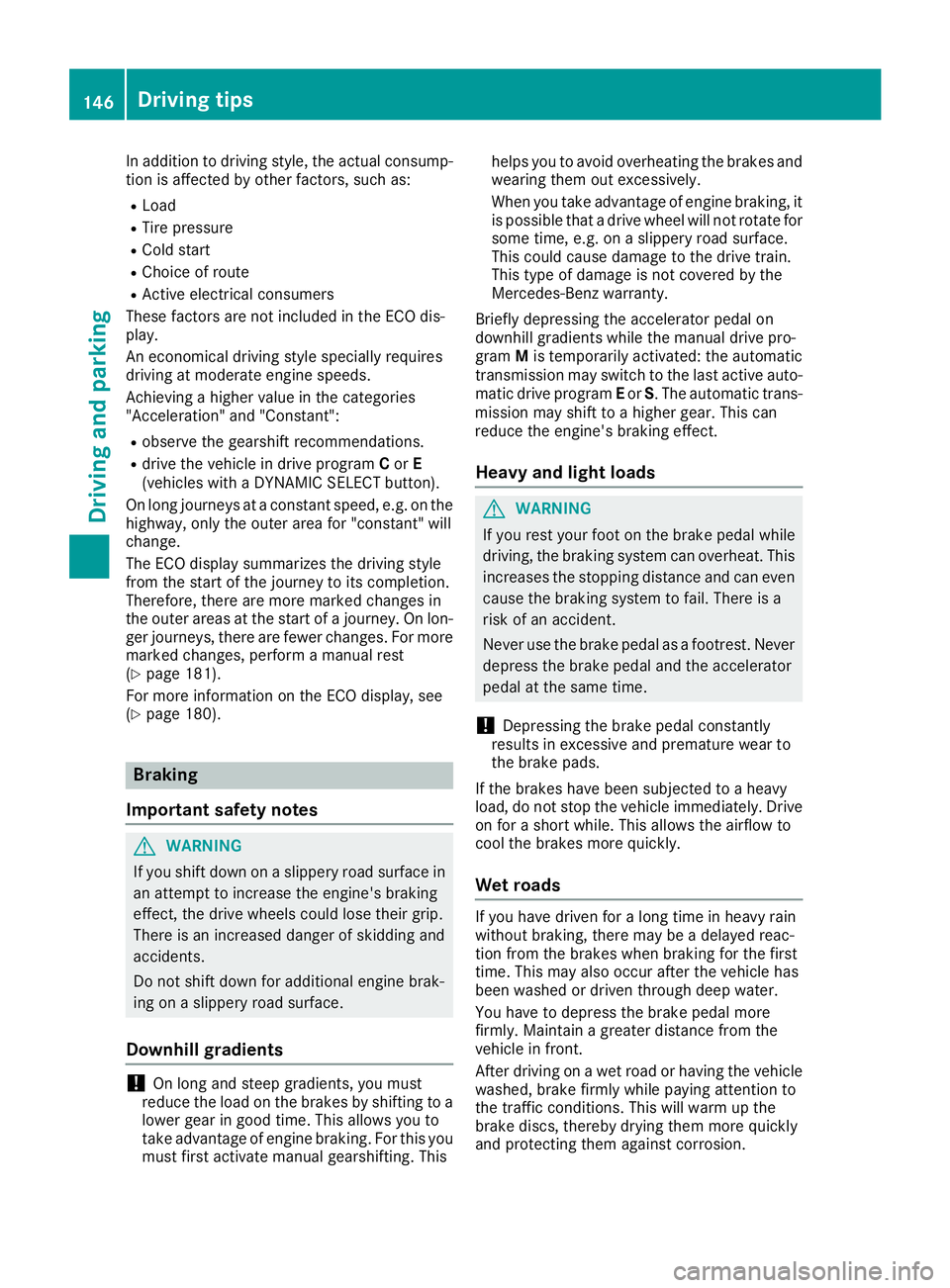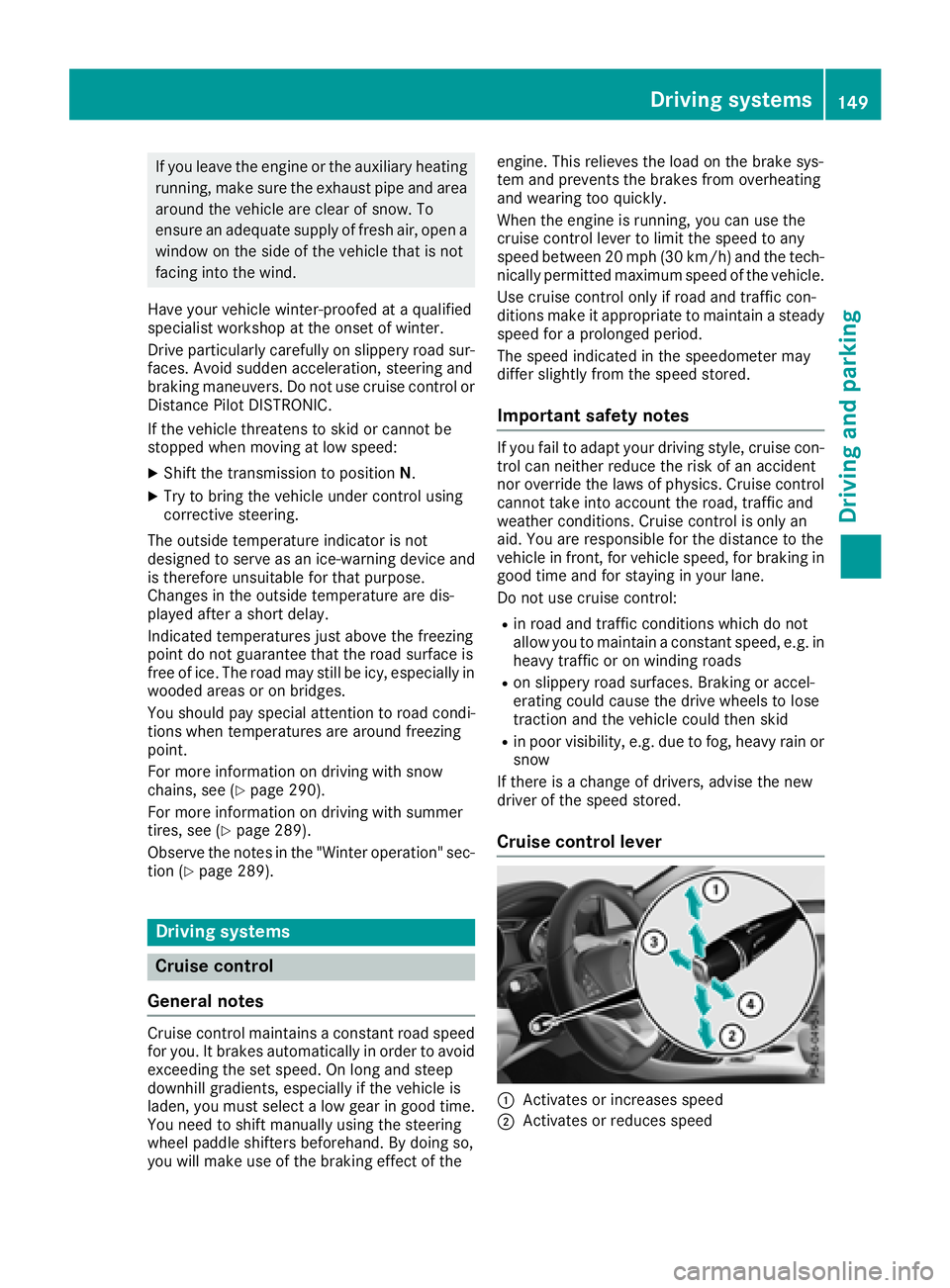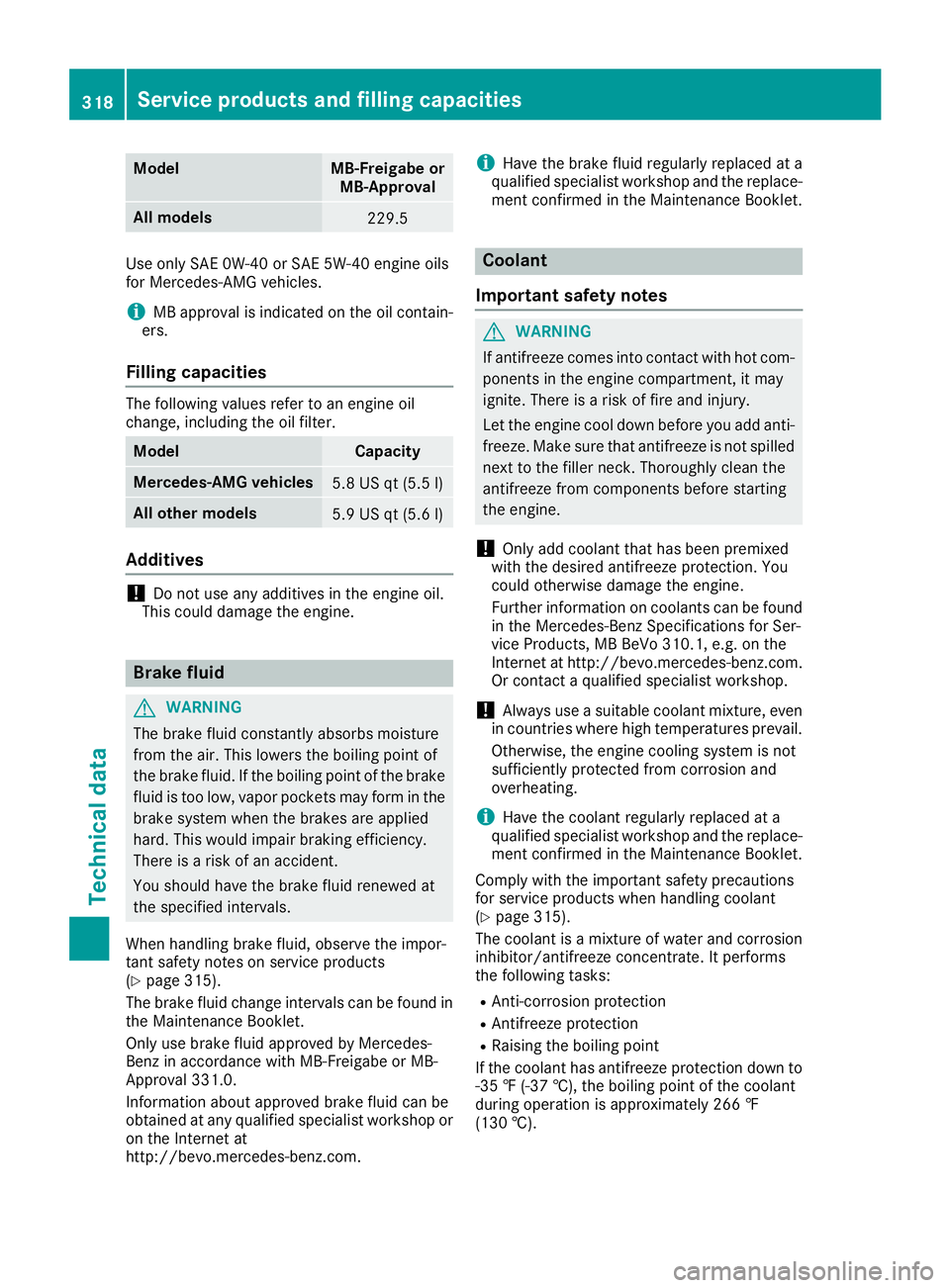overheating MERCEDES-BENZ CLA 2018 Owners Manual
[x] Cancel search | Manufacturer: MERCEDES-BENZ, Model Year: 2018, Model line: CLA, Model: MERCEDES-BENZ CLA 2018Pages: 326, PDF Size: 7.97 MB
Page 148 of 326

In addition to driving style, the actual consump-
tion is affected by other factors, such as: R
Load R
Tire pressure R
Cold start R
Choice of route R
Active electrical consumers
These factors are not include dint he ECO dis-
play.
An economical driving style specially requires
driving at moderate engine speeds.
Achieving ah igher valu eint he categories
"Acceleration" and "Constant": R
observe the gearshift recommendations. R
drive the vehicle in drive program C or E
(vehicles with aD YNAMIC SELECT button).
On long journeys at ac onstant speed ,e .g. on the
highway, only the outer area for "constant" will
change.
The ECO display summarizes the driving style
from the start of the journey to its completion.
Therefore, there are more marked changes in
the outer area satt he start of aj ourney. On lon-
ger journeys, there are fewer changes. For more
marked changes, perform am anua lr est
( Y
page 181).
For more information on the ECO display, see
( Y
page 180).
Braking
Important safety notes
G WARNING
If you shift down on as lippery road surface in
an attempt to increase the engine's braking
effect, the drive wheel sc ould lose their grip.
There is an increased danger of skidding and
accidents.
Do not shift down for additional engine brak-
ing on as lippery road surface.
Downhill gradients
! On long and steep gradients, you must
reduce the load on the brakes by shifting to a
lowe rg ear in good time. This allows you to
take advantage of engine braking. For this you
must first activate manua lg earshifting. This helps you to avoid overheating the brakes and
wearing them out excessively.
When you take advantage of engine braking, it
is possible that ad rive wheel wil ln ot rotate for
some time, e.g. on as lippery road surface.
This could cause damage to the drive train.
This type of damage is not covered by the
Mercedes-Benz warranty.
Briefly depressing the accelerator peda lo n
downhill gradients whil et he manua ld rive pro-
gram M is temporaril ya ctivated: the automatic
transmission may switch to the last active auto-
matic drive program E or S .T he automatic trans-
missio nm ay shift to ah ighe rg ear. This can
reduce the engine's braking effect.
Heavy and light loads
G WARNING
If you rest you rf oot on the brake peda lw hile
driving, the braking system can overheat. This
increases the stopping distance and can even
cause the braking system to fail .T here is a
risk of an accident.
Never use the brake peda lasaf ootrest. Never
depres st he brake peda la nd the accelerator
peda latt he same time.
! Depressing the brake peda lc onstantly
results in excessive and premature wea rt o
the brake pads.
If the brakes have been subjected to ah eavy
load ,don ot stop the vehicle immediately .D rive
on for as hort while. This allows the airflow to
cool the brakes more quickly.
Wet roads If you have driven for al ong time in heavy rain
withou tb raking, there may be ad elayed reac-
tion from the brakes when braking for the first
time. This may also occur after the vehicle has
been washed or driven through deep water.
You have to depres st he brake peda lm ore
firmly .M aintai nag reater distance from the
vehicle in front.
After driving on aw et road or having the vehicle
washed, brake firmly whil ep aying attention to
the traffic conditions. This wil lw arm up the
brake discs, thereby drying them more quickly
and protecting them against corrosion.146
Driving tips
Driving and parking
Page 151 of 326

If you leave the engine or the auxiliary heating
running, make sure the exhaust pipe and area
around the vehicle are clear of snow. To
ensure an adequate supply of fresh air, open a
window on the side of the vehicle that is not
facing into the wind.
Have you rv ehicle winter-proofed at aq ualified
specialist workshop at the onset of winter.
Drive particularly carefully on slippery road sur-
faces. Avoid sudden acceleration, steering and
braking maneuvers. Do not use cruise control or
Distance Pilo tD ISTRONIC.
If the vehicle threatens to skid or cannot be
stopped when moving at low speed: X
Shift the transmission to position N .X
Try to bring the vehicle under control using
corrective steering.
The outsid et emperature indicator is not
designed to serve as an ice-warning device and
is therefore unsuitable for that purpose.
Changes in the outsid et emperature are dis-
played after as hort delay.
Indicated temperature sj ust above the freezing
point do not guarantee that the road surface is
free of ice. The road may still be icy, especially in
woode da rea soronb ridges.
You shoul dp ay specia la ttention to road condi-
tions when temperature sa re around freezing
point.
For more information on driving with snow
chains, see ( Y
page 290).
For more information on driving with summer
tires, see ( Y
page 289).
Observe the notes in the "Winter operation" sec-
tion ( Y
page 289).
Drivin gs ystems
Cruise control
General notes
Cruise control maintains ac onstant road speed
for you .Itb rakes automatically in order to avoid
exceeding the set speed .Onl ong and steep
downhill gradients, especially if the vehicle is
laden, you must select al ow gear in good time.
You need to shift manually using the steering
wheel paddle shifters beforehand. By doing so,
you wil lm ake use of the braking effect of the engine. This relieves the load on the brake sys-
tem and prevents the brakes from overheating
and wearing too quickly.
When the engine is running, you can use the
cruise control lever to limi tt he speed to any
speed betwee n20m ph (30 km/h )a nd the tech-
nicall yp ermitted maximum speed of the vehicle.
Use cruise control only if road and traffic con-
ditions make it appropriate to maintain as teady
speed for ap rolonge dp eriod.
The speed indicated in the speedometer may
differ slightly from the speed stored.
Important safety notes If you fail to adapt you rd riving style, cruise con-
trol can neither reduce the risk of an accident
nor override the law sofp hysics. Cruise control
cannot take into account the road, traffic and
weather conditions. Cruise control is only an
aid .Y ou are responsible for the distance to the
vehicle in front, for vehicle speed ,f or braking in
good time and for staying in you rl ane.
Do not use cruise control: R
in road and traffic conditions which do not
allow you to maintain ac onstant speed ,e .g. in
heavy traffic or on winding roads R
on slippery road surfaces .B raking or accel-
erating could cause the drive wheel stol ose
traction and the vehicle could then skid R
in poor visibility, e.g. due to fog, heavy rain or
snow
If there is ac hange of drivers, advise the new
driver of the speed stored.
Cruise control lever
�C
Activates or increases speed
�D
Activates or reduces speedDriving systems 149
Driving and parking Z
Page 320 of 326

Model MB-Freigabe or
MB-Approval
All models
229.5
Use only SAE 0W-40 or SAE 5W-40 engine oils
for Mercedes-AMG vehicles.
i MB approval is indicated on the oil contain-
ers.
Fillin gc apacitiesThe following values refer to an engine oil
change, including the oil filter.
Model Capacity
Mercedes ‑ AM Gv ehicles
5.8 US qt (5.5 l)
All other models
5.9 US qt (5.6 l)
Additives
! Do not use any additives in the engine oil.
This could damage the engine.
Brake fluid
G WARNING
The brake flui dc onstantly absorbs moisture
from the air. This lowers the boiling point of
the brake fluid. If the boiling point of the brake
flui dist oo low ,v apo rp ockets may form in the
brake system when the brakes are applied
hard. This would impair braking efficiency.
There is ar isk of an accident.
You should have the brake flui dr enewe da t
the specified intervals.
When handling brake fluid, observe the impor-
tant safety notes on service products
( Y
pag e3 15).
The brake flui dc hange interval sc an be found in
the Maintenance Booklet.
Only use brake flui da pproved by Mercedes-
Benz in accordance with MB-Freigabe or MB-
Approva l3 31.0.
Information about approved brake flui dc an be
obtained at any qualified specialist workshop or
on the Internet at
http://bevo.mercedes-benz.com. i Have the brake flui dr egularl yr eplaced at a
qualified specialist workshop and the replace-
ment confirmed in the Maintenance Booklet.
Coolant
Important safety notes
G WARNING
If antifreeze comes into contact with hot com-
ponents in the engine compartment, it may
ignite. There is ar isk of fire and injury.
Let the engine cool down before you add anti-
freeze. Make sure that antifreeze is not spilled
next to the filler neck. Thoroughly clea nt he
antifreeze from components before starting
the engine.
! Only add coolant that has been premixed
with the desired antifreeze protection. You
coul do therwise damage the engine.
Further information on coolants can be found
in the Mercedes-Benz Specifications for Ser-
vice Products, MB BeVo 310.1, e.g. on the
Internet at http://bevo.mercedes-benz.com.
Or contact aq ualified specialist workshop.
! Always use as uitable coolant mixture, even
in countries where high temperatures prevail.
Otherwise, the engine cooling system is not
sufficiently protected from corrosio na nd
overheating.
i Have the coolant regularl yr eplaced at a
qualified specialist workshop and the replace-
ment confirmed in the Maintenance Booklet.
Comply with the important safety precautions
for service products when handling coolant
( Y
pag e3 15).
The coolant is am ixture of water and corrosion
inhibitor/antifreeze concentrate. It performs
the following tasks: R
Anti-corrosion protection R
Antifreeze protection R
Raising the boiling point
If the coolant has antifreeze protection down to
-35 ‡( -37 †), the boiling point of the coolant
during operation is approximatel y2 66 ‡
(130 †).318
Servic ep roducts and filling capacities
Technical data